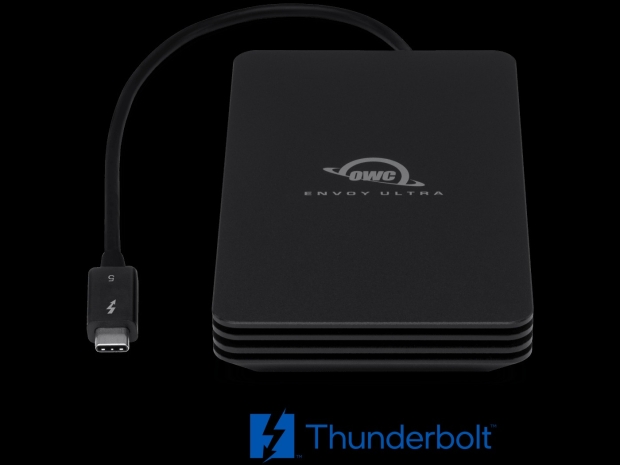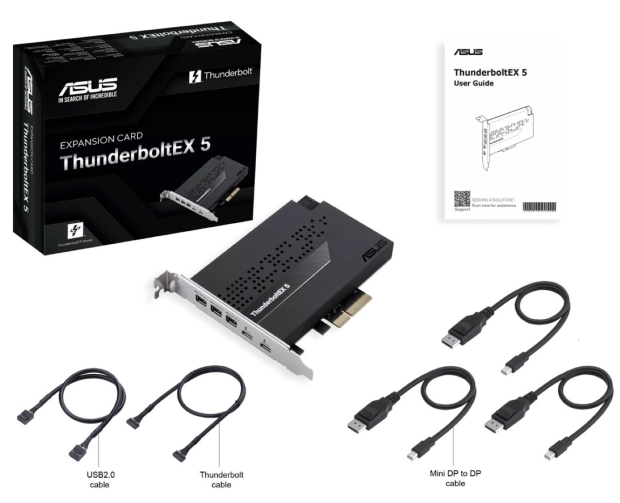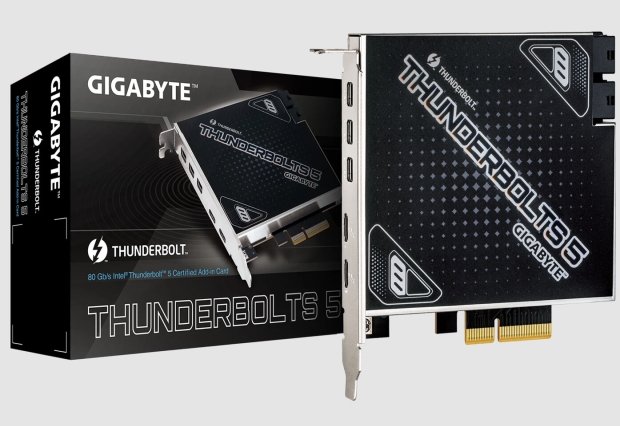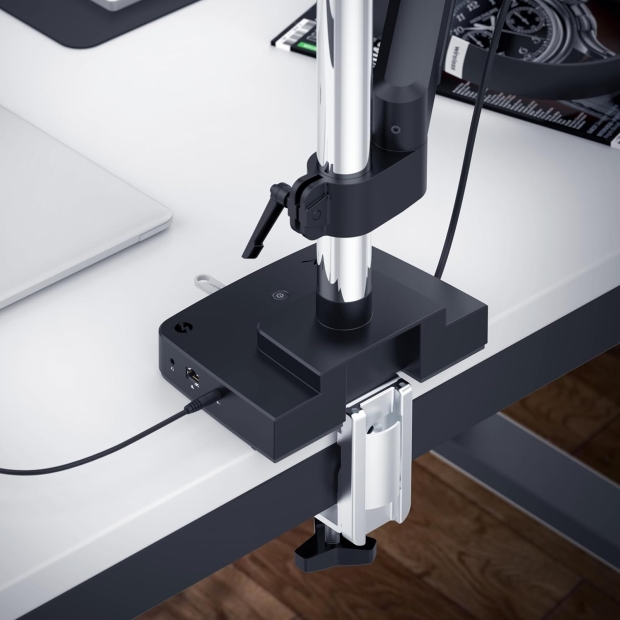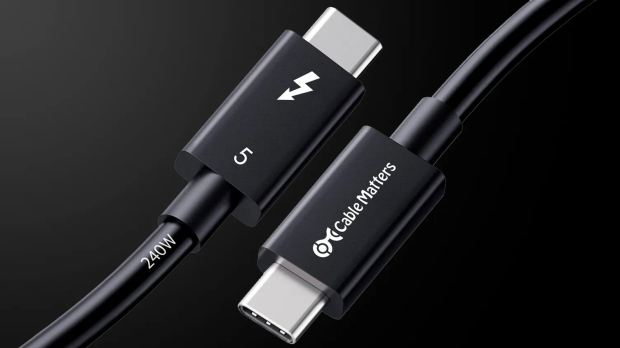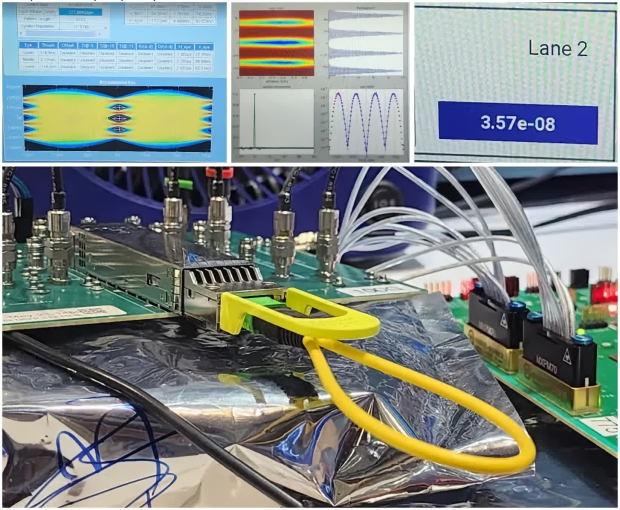Connectivity & Cloud
The latest and most important Connectivity & Cloud news.
OWC unveils Thunderbolt 5 products ready for Apple's new M4-powered Mac mini, MacBook Pro
Other World Computing (OWC) has just unveiled its new Thunderbolt 5 external SSD and cable, ready for Apple's new M4-powered Macs, and Thunderbolt 5-ready PCs and laptops.
OWC is today introducing its Envoy Ultra SSD and OWC Thunderbolt 5 (USB-C) cables, ready for Apple's new Mac mini powered by the new M4 Pro processor, and the new MacBook Pro laptops powered by the M4 Pro and M4 Max processors.
Larry O'Connor, CEO and Founder, Other World Computing (OWC) said: "Thunderbolt 5 unlocks a new world of possibilities for users, and OWC is proud to be at the forefront of this exciting evolution. With the Envoy Ultra SSD and our Thunderbolt 5 cables, we're giving Mac Mini and MacBook Pro users the speed, reliability, and power they need to push their workflows further than ever before - whether they're editing 8K video, managing massive data sets, or just staying connected on the go." He continued, "And, don't blink - because OWC is set to roll out even more Thunderbolt 5 innovations, including the powerful OWC Thunderbolt 5 Hub, set for release in November".
ASUS launches Thunderbolt 5 add-in card: up to 120Gbps bandwidth, with DisplayPort 2.1 support
ASUS has just joined the Thunderbolt 5 add-in card (AIC) party with the introduction of its new ASUS ThunderboltEX 5 AIC, right after GIGABYTE announced its new Thunderbolts 5 AIC.
The new ASUS ThunderboltEX 5 AIC has a single 6-pin PCIe power connector, with ASUS claiming it has USB-PD support of up to 130W through an in-house feature ASUS calls Flexible FastCharge. A single USB Type-C port is limited to a maximum of 96W, which will handle an Apple MacBook Pro laptop but not other laptops that are 100W+ power.
Inside, ASUS is using the same Intel JHL9580 Thunderbolt 5 controller that powers the GIGABYTE Thunderbolts 5 AIC, as well as using a PCIe 4.0 4 interface with support for up to 3 x DisplayPort 2.1-based 8K monitors at 60Hz refresh rate, but ASUS underlines that this will require DSC (Display Stream Compression) technology.
GIGABYTE launches Thunderbolts 5 AIC with Thunderbolt 5 ports with Gen4 interface
GIGABYTE has just silently released its first Thunderbolt 5 add-in card (AIC) with the introduction of Thunderbolts 5, yeah... what an original name.
Inside, there's nothing much going on that differentiates Thunderbolts 5 from a regular Thunderbolt 4 card except that we have 3 x Mini DisplayPort inputs, and two USB Type-C outputs with up to 100W USB-PD charging thanks to the 6-pin PCIe power connector giving the GIGABYTE Thunderbolts 5 AIC some more juice.
GIGABYTE is tapping Intel's new JHL9580 "Barlow Ridge" controller, with native support for DisplayPort 2.1 and support of resolutions of up to 8K 60Hz, and data speeds of 80Gbps or a blistering 120Gbps in asymmetric mode. Intel's new JHL9580 controller uses a PCIe 4.0 x4 interface, which matches ASMedia's new ASM4242 USB4 host controller, and a big upgrade from the PCIe 3.0 support on Intel's former Thunderbolt 4 controllers.
World's first USB4 2.0 cables receive certification for double transfer speeds
The next big jump in USB speeds is about to be here, and while it will take some time before we see or even need these kind of speeds in our everyday devices, the technology is now a reality.
Elecom has become the first company to certify its USB4 2.0 cables, which are slated to provide speeds that are double USB4 1.0 cables. Reports indicate that Elecom is looking to December to release two variants of the USB4 2.0 cable, and as per the specification, the base cable will be able to provide 80 Gbps throughput and 60W of charging, while the other variant is capable of 240W of charging at 48V/5A. Currently, it appears USB4 2.0 cables are limited regionally to Japan, but within the coming months, we can expect an expansion to other regions.
The 240W charging capability is more than enough to charge devices such as smartphones, tablets, laptops, handheld gaming devices, and power banks. Moreover, these cables will support DisplayPort passthrough of up to 8K at 60Hz, which means they should be capable of 4K at 120Hz. As for devices coming with USB4 2.0 ports, it will still be quite some time before we see widespread adoption.
Bluetooth 6.0 specs add centimeter-level accuracy device tracking, improved device pairing
The Bluetooth Special Interest Group (Bluetooth SIG) has just released version 6.0 of the Bluetooth standard, and with it, come some upgrades since the last major version -- Bluetooth 5.0 -- launched all the way back in 2016.
The new Bluetooth 6.0 standard has two new features that assist in reducing power consumption: Decision-Based Advertising Filtering and Monitoring Advertisers. These new features help the upgraded Bluetooth 6.0 devices reduce power consumption, and increase efficiency making sure that they're only scanning for data packets when they receive data on their primary channel, relevant to their application.
Bluetooth 6.0 is also capable of telling devices when another device they want wants to connect to, moves out of range, so that they can cancel their attempts of making a connection and conserve energy. Another big feature is Bluetooth Channel Sounding, a new technology that provides two upgrades to Bluetooth devices: enhanced security, and improved accuracy in location finding.
Sabrent's new Thunderbolt 4 Docking Station with Monitor Desk Mount: supports up to 3 displays
Sabrent wants to provide even more functionality to your lifestyle with a new Thunderbolt 4 Docking Station with Monitor Desk Mount, using a gas-lift arm that supports up to two monitors.
The new Thunderbolt 4 Docking Station with Monitor Desk Mount (DS-T4WA) docking station connects through the ultra-fast Thunderbolt 4 standard, delivering a Thunderbolt 4 downstream port that's joined by 4 USB ports (2 x 10Gbps USB 3.2 Gen2x1, 1 x 10Gbps USB-A, and 1 x 5Gbps USB 3.2 Gen1x1)
Sabrent bakes in a UHS-II (312Mbps) microSD/SD card reader, a 3.5-inch audio in/out port, and gigabit ethernet (1GbE) for fast and reliable wired network connectivity. It's virtually got it all, and don't forget there's a monitor mount there, too.
Starlink's new mobile community gateway tested: 8Gbps down with 'no land in sight'
SpaceX VP for Starlink Engineering Michael Nicolls has posted a juicy new Speedtest run on Starlnk's new mobile community gateway capability, with some mighty impressive 8Gbps download speeds, and 2.8Gbps upload speeds, with "no land in sight" he added.
In the post on X, the Starlink mobile community gateway was tested, which the Elon Musk-led company is preparing the technology for use on naval ships and airplanes, with blistering-fast speeds. SpaceX VP for Starlink Engineering Michael Nicolls performed the speed tested near Jacksonville, Florida, with "no land in sight" which means the test of Starlink's new mobile community gateway was either from the air, or from the sea.
SpaceX and Tesla CEO Elon Musk replied to the post, adding: "For large commercial and community users, the Starlink Gateway terminal provides over 8Gbps od download and soon over 8Gbps uplink too".
Japan tests world's fastest internet connection with 402Tbps: download speeds of 50TB/sec
Face it, we all want the fastest internet connection speed possible... downloading games in just milliseconds sounds like it'll never happen. But now, Japanese researchers have done it: hitting 400Tbps internet connectivity speeds, forming a new world record.
In a new report by Japan's National Institute of Information and Communications Technology, the team reported that they hit speed of a truly insane 402 Terabits per second (402Tbps). The previous records for internet connectivity speeds were breached in October 2023, with 321Tbps, and then back in March 2022, with 226Tbps. 402Tbps is a damn big leap in speeds, which is why they achieved a new world record.
402Tbps works out to an astonishing 50TB/sec download speeds, which no computer on the planet could handle, period. Most systems feature on-board 1GbE ethernet connectivity, allowing for 110MB/sec speeds, while 10GbE can usher in over 1TB/sec (1000MB/sec+). So even with 10GbE ethernet, you're not going to get anywhere near 50TB/sec, and even the fastest Gen5 SSDs are pushing 14GB/sec.
This is the world's first Thunderbolt 5 cable: insane 120Gbps bandwidth, 240W charging for $23
The world's first Thunderbolt 5 cable has just been unleashed, with Cable Matters unveiling its new Thunderbolt 5 cable that enjoys its full 120Gbps of bandwidth and 240W of charging... starting from just $23.
Cable Matters' new Thunderbolt 5 cable is manufactured by Lintes Technology and is available from Cablle Matters' own Amazon store. The 1ft cable costs $22.99, the 1.6ft cable costs $26.99, and finally, the largest 3.3ft cable costs $32.99.
Thunderbolt 5 has a single standard, so you will enjoy the full specs, bandwidth, and power of Thunderbolt 5 no matter the cable length. This includes 120Gbps of uni-directional bandwidth, up to 80Gbps of bidirectional bandwidth, up to 240W of power delivery, and backward compatibility with Thunderbolt 4 and Thunderbolt 3 Type-C ports (as well as USB4 and USB Type-C).
Cadence teases PCIe 7.0 hitting 128GT/s with optical PCIe connections, successor to CopprLink
Cadence stole the show recently at the PCI-SIG DevCon 2024 event, and in honor of the 32nd anniversary of the PCI-SIG Developer's Conference, Cadence announced a complete PCIe 7.0 IP solution for HPC and AI markets of the future.
The AI boom is creating a gigantic demand for faster-than-ever chips, which demand next levels of throughput, low latency, and power efficiency. This is fueling technology enhancements across the board, with Cadence being a close PCI-SIG member, the company says it has "valuable early insights into the evolving specs and the latest compliance standards".
HPC and AI systems of the future will require radically more bandwidth as that train never stops in the technology industry, especially for these important silicon-heavy environments. Direct GPU-to-GPU communication is absolutely critical for these systems, communicating heavy computational tasks across multiple GPUs or AI accelerators inside of a server or AI computing pod.


